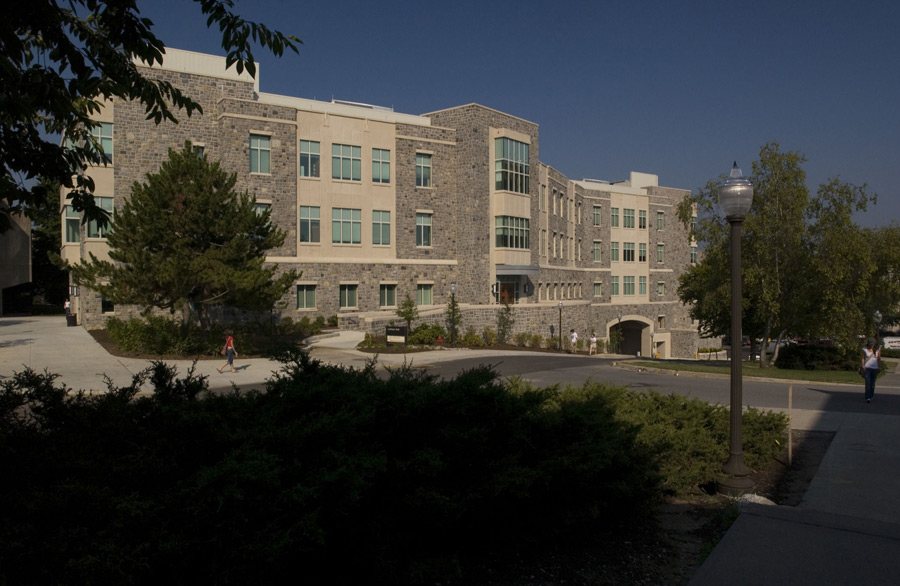Agriculture and Life Sciences, Natural Resources colleges celebrate new research facility

Today, Virginia Tech celebrated the opening of Latham Hall, its new 84,000-square-foot, state-of-the-art agriculture and natural resources research facility, with an open house and dedication ceremony that included remarks by Lt. Gov. Bill Bolling and university administrators.
“As the home of researchers for the College of Agriculture and Life Sciences and the College of Natural Resources, the Latham building will play a very important role in the future of Virginia Tech and the expansion of agribusiness in Virginia,” said Lt. Gov. Bolling. “I am most appreciative to the people of Virginia for approving the construction of this building in 2002, and to my good friends Bill and Betty Latham for their most generous gift that will support student and faculty research far into the future.”
The $28.5 million facility, located on the Blacksburg campus between Cheatham and Smyth halls, will allow for the expansion of groundbreaking research in agriculture, natural resources, and other life science areas.
“Latham Hall provides our researchers a home to foster multi-disciplinary collaboration and partnerships that will bridge many sectors of science and help to actively engage our faculty to find research-based solutions to today’s problems,” said Charles W. Steger, president of Virginia Tech.
Latham Hall houses research areas that include biodesign, bioprocessing, fisheries and wildlife, geography, forestry, water, infectious diseases, plant pathogen-environment interactions, and soils.
“While providing wonderful co-learning opportunities to students, scientists with complimentary research interests will have the opportunity to share information and foster multi-disciplinary programs,” said Sharron Quisenberry, dean of the College of Agriculture and Life Sciences. “This collaborative interaction will help us [Virginia Tech] to conduct life altering research through bioinformatics, critical technologies, biomedical applications, and biotechnology.”
“The building will aid in recruitment and retention of world-class faculty and provide faculty and students the opportunity to expand their knowledge and research capabilities to a new level,” said Michael Kelly, dean of the College of Natural Resources. “The facility will not only enhance research and education, but transform the natural resource industry.”
Examples of research being conducted in the facility include:
-- The development of a selective insecticide that is safe for humans, affordable to developing countries, and that can be ultimately used on bednets to protect against mosquitoes, the carrier of malaria and other infectious diseases.
-- The identification of forest management practices that are most cost-effective and offer the greatest benefit to protecting water and site quality.
-- The utilization of genetic and genome-scale approaches to understand the function and evolution of genes that enable plants to resist disease-causing pathogens that often cause devastating effects on agriculture productivity.
-- Work that aids in understanding how a changing global environment affects the health of declining wildlife and provides a scientific foundation for making informed conservation decisions.
-- The improvement of plant breeding programs of economically important crops such as soybeans, peanuts, wheat, and barley in order to increase their nutritional value and enhance their natural defenses so that fewer synthetic chemicals are needed to control weeds and pests.
-- The development of techniques to enhance opportunities for bio-renewable energy.
The building was named and dedicated in honor William and Elizabeth Latham of Haymarket, Va. The Lathams provided a $5 million gift to the university to establish an endowed fund to support the academic research in the College of Agriculture and Life Sciences.
“The Lathams’ gift will provide an enduring contribution to cutting-edge research and education at Virginia Tech, which will help support the needs of production agricultural industries,” said Quisenberry. “Their endowment will fund equipment and support undergraduate research stipends and graduate student fellowships in our college and ensure state-of-the–art research in Latham Hall through time.”
Latham Hall represents more than 25 years of planning by the College of Agriculture and Life Sciences – back to when the College of Natural Resources was the School of Forestry within the college. The Virginia Higher Education Bond Referendum passed in 2002 provided the funds for construction.
Nationally ranked among the top research institutions of its kind, Virginia Tech’s College of Agriculture and Life Sciences focuses on the science and business of living systems through learning, discovery, and engagement. The college’s comprehensive curriculum gives more than 1,600 students in a dozen academic departments a balanced education that ranges from food and fiber production to economics to human health. Students learn from the world’s leading agricultural scientists, who bring the latest science and technology into the classroom.
The College of Natural Resources at Virginia Tech consistently ranks among the top five programs of its kind in the nation. Faculty members stress both the technical and human elements of natural resources and instill in students a sense of stewardship and land-use ethics. Areas of studies include environmental resource management, fisheries and wildlife sciences, forestry, geospatial and environmental analysis, natural resource recreation, urban forestry, wood science and forest products, geography, and international development.






.jpg.transform/m-medium/image.jpg)
